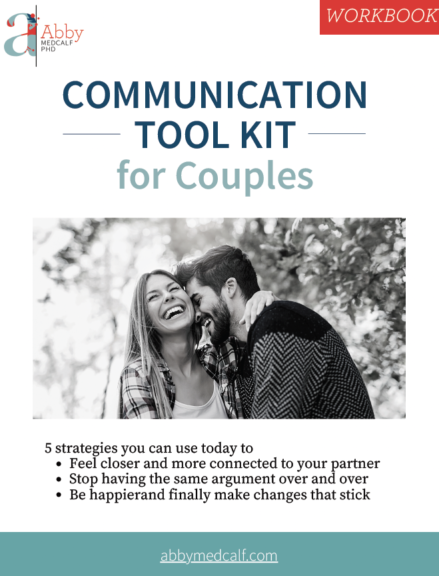
Negotiating in relationships can be tough. When we’re trying to find common ground, but we’ve got different points of view, there’s a feeling of competition which means there’s an underlying winning and losing mentality going on. With this mindset, each person walks away feeling like they gave up more than they wanted, which leads to disconnection, resentment, and frustration. But today, we’re going to change all that because you’re going to learn my five steps to effective negotiation in all your relationships so you can both walk away feeling connected, supported, and heard.
8-minute read
Negotiation often boils down to arguments that devolve into one person dominating and one acquiescing or both sides trying to “meet in the middle” but not knowing how to find that. In the end, no one is fully happy with the compromise, and again, it feels like you’re on opposite teams with a winner and a loser (even if you both think you lost). I’ve been preaching for a long time that you need to approach differences and negotiations from a “we” perspective. I did a whole TEDx Talk about how this opposite sides thing is the real reason relationships fail, but this isn’t just about romantic relationships. This thinking applies to all your relationships. So, whether you’re thinking about an issue with your boss, mom, coworker, or friend, today’s teachings apply to you.
It’s interesting because, when you look up consensus in the dictionary, you find words like harmony, solidarity, and unity in the definition. It means “accordance in opinion or feeling.” This is important because, even if you can’t get behind the opinion or thinking of the other person, I want you to get behind their feelings. The word consensus comes from the Latin word consentio, which literally means to feel together.
If you want to negotiate successfully and come to true consensus, you’ve got to make feelings, not facts, the priority. Too often, people focus on the “facts” and don’t talk about the feelings involved. Since we connect with feelings, not thoughts, it’s important to acknowledge, identify and understand those feelings so you can get on the same team and find that elusive common ground.
Enjoying the Relationships Made Easy podcast? Please leave a review! This helps more people find us and helps the podcast grow. Head on over to wherever you listen to the podcast, and write a review!
The Three Rules of Consensus Decision-Making:
There are three important, overarching rules when it comes to consensus decision-making:
- It’s fair: everyone has equal input into the process
- It’s collaborative: each person’s input is actively solicited and valued
- It’s cooperative: it’s not about competing for individual preferences; it’s taken on with an intention of working together and uniting.
Starting from this point of fairness, collaboration, and cooperation, you can see how any negotiation is going to be better than the usual “I win, you lose” mentality we have in most of our relationships. But how exactly do you get there? You follow my five steps for effective negotiation and decision-making.
The Five Steps for Effective Negotiation and Decision-Making
Step #1: Check Yourself Before You Wreck Yourself
In his book Getting to Yes with Yourself, Harvard Negotiation Project cofounder William Ury says that our biggest obstacle in any negotiation is ourselves. I know you want to blame timing, your boss, your dog, or your lack of power or influence, but it’s really you that gets in the way of your success the most. He writes, “We sabotage ourselves by reacting in ways that do not serve our true interests.” We can all relate to reverting to old patterns and behaviors when we’re in a negotiation as we act defensively, lose our temper, say yes when we mean no, or withdraw instead of asserting ourselves. We get angry or impatient, which leads us to make choices and concessions we regret later on.
Learning to be more self-aware and understand our unhealthy patterns and cycles is the first step to making them stop. If you keep doing what you’ve always done, you’re going to get what you’ve always got. It’s time to learn the four ways to be more self-aware and to diligently work on raising your emotional intelligence. At the very least, before you enter a negotiating discussion, note how you’re feeling and get yourself to a good-feeling place first. Know what your limitations are and work around them as you pull from your strengths.
Step #2: Change the Paradigm
Negotiations are generally set up along a straight line, and that’s where the problems begin. You’re at point A on the line, and the other person is at the other end, at point B. You’re trying to come to some agreement “in the middle” along this imaginary line, and you end up in a tug-of-war as you try to pull them towards your way of thinking, and they try to pull you over towards their ideas of what’s right.
We naturally resist because we don’t want to lose! It’s time to go into any decisions or discussions with a new paradigm: negotiating and coming to consensus is a triangle, not a line. Think of you and the other person still as point A and point B, but now you’re at the base points of a triangle instead of a line. The consensus point is up there at point C on the top of the triangle!
You’re going to come up with a new idea together that neither of you had thought of before. You’re going to approach this as neither of you being right but, instead, as a discovery and brainstorming mission. Neither of you knows yet where it might end up but point C is something you both buy into. Even if you end up deciding on “your way” or the other person’s initial plan, this process of open inquiry and collaboration will ensure buy-in from both of you when it’s all said and done. You know you’re brainstorming effectively when you come up with many more solutions or ideas than the two sides you started with. There are always many answers to any issue, so make sure you’re allowing yourself the freedom to really expand your thinking and wonder.
It’s time to learn to listen without getting defensive or hurt.
Step #3: Set out to Understand, not to be Understood
You’ve got to start with setting a conscious intention or goal of being curious. I talk a lot about setting an intention and getting yourself ready for these types of conversations. You’ve got to spend some time beforehand getting yourself into that good-feeling place. Don’t go in anxious or worried! The other person will pick up on that, and you’ll be screwed before you start. Instead, focus on how you want that conversation to go, not what you’re afraid might happen.
- It’s my intention to listen to my friend with an open mind and an open heart.
- It’s my intention that my coworker will feel heard and understood.
- It’s my intention that my partner and I will both walk away from this conversation feeling more connected.
- It’s my intention to stay mindful throughout this conversation and notice any unwanted feelings.
- It’s my intention to focus on being patient and asking questions instead of making statements.
Get out of thinking you’re right and, instead, set yourself up to truly wonder what the other person is thinking and what’s driving their thoughts and actions. You want to make it your intention to listen as if you’re wrong! This comes down to asking yourself, “Do I want to be correct or effective?” Correct is you’re right, and you get to bulldoze through and get your agenda passed. Effective is having a connected conversation and a relationship built on trust and goodwill. You need to choose.
Want to learn how to set intention? It only takes 18 seconds and it’ll help you be an excellent negotiator!
Step #4: Ask Collaborative Questions
I’ve said this one often, you can’t SAC your relationships. Don’t make Suggestions, offer Advice, or Criticize in this (or any) conversation. Instead, you’re going to be curious and ask collaborative questions with the intention of having a better understanding of what the other person wants and needs. What’s driving their thinking? What’s underneath what they’re saying they want? Try to stay away from “Why?” questions which tend to put people on the defensive. You might start with questions like:
- Can you tell me more about X?
- Can you say more about why you feel so strongly about Y?
- What do you mean by X? Can you give me another example?
- What’s something I haven’t asked that would help move this conversation forward?
Download my list of Collaborative Questions to help you become a master negotiator!
In the end, make sure you’re not making or holding any assumptions about what the other person thinks or wants. You’re asking questions with curiosity; you’re not driving towards a conclusion.
Step #5: Check in with Feelings During the Talk
Starting off a conversation in a healthy way is, obviously, your priority. But your next concern is making sure that you stay present throughout the discussion. If you’re not mindful as you have this talk, you’ll end up devolving into old, negative patterns.
I preach mindfulness all the time because, without it, you can learn all these great tools, but you won’t remember to use them in the moment! I highly recommend checking in with how you and the other person are feeling at least once during this conversation. Simply stop what you’re saying and ask, “How are you feeling right now?” Let me warn you that the other person will almost certainly give you a thought they’re having but stick with this question and keep asking until they name actual feelings. You can help them out by sharing how you’re feeling right then too.
Remember, we connect with feelings, not thoughts, and connection is key to having a successful negotiation. You have to connect, to correct. If you’re trying to create a mutually understanding dialogue, there needs to be some connection, and feelings are the way to get there.
Resources for Five Steps to Effective Negotiation in All Your Relationships
TEDX Talk: The Real Reason Relationships Fail, Dr. Abby Medcalf
Four Ways to be More Self-Aware
Dealing with Low Emotional Intelligence in Yourself or Others
How to Listen Without Getting Defensive or Hurt
How to Set Intentions in Just 18 Seconds (aka The 18-Second Shift)
Grab my Free List of Collaborative Questions







